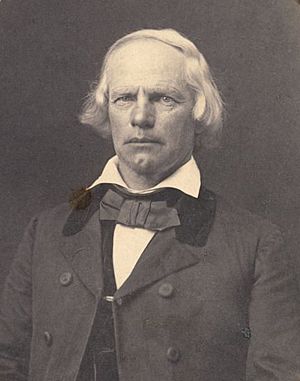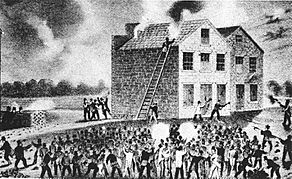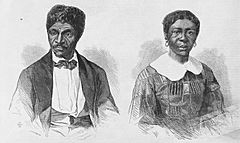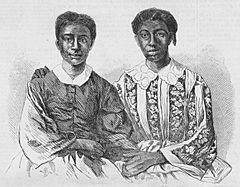Francis B. Murdoch facts for kids
Quick facts for kids
Francis B. Murdoch
|
|
|---|---|
 |
|
| Born |
Francis Butter Murdoch
March 21, 1805 Cumberland, Maryland, United States
|
| Died | May 10, 1882 (aged 77) San Jose, California, United States
|
| Occupation | Attorney Newspaper publisher |
| Known for | Freedom suits attorney Founder of San Jose Telegraph |
Francis B. Murdoch (born March 21, 1805 – died May 10, 1882) was an American lawyer and newspaper publisher. He worked as a lawyer in several states, including Pennsylvania, Michigan, Illinois, and Missouri. In 1846, he helped Dred Scott and Harriet Robinson Scott begin their famous "freedom suits." These were legal cases where enslaved people tried to win their freedom.
Between 1840 and 1847, Murdoch filed almost one-third of all freedom suits in St. Louis. He helped many enslaved people gain their freedom, including Polly Berry and her daughter Lucy A. Delaney. Before this, Murdoch was the city lawyer in Alton, Illinois. There, he tried to prosecute people who killed Elijah Parish Lovejoy, a newspaper publisher who was against slavery, in 1837. After moving to California in 1852, Murdoch started publishing newspapers. He founded the San Jose Telegraph, which later became The Mercury News, and also started the San Jose Patriot.
Contents
Early Life and Learning
Francis Butter Murdoch was born on March 21, 1805, in Cumberland, Maryland. When he was 19, he went to a school called an academy in Bedford, Pennsylvania. He studied law under Judge Alexander Thomson. Soon after, he was allowed to practice law in Pennsylvania. Francis Murdoch and Eliza Kimmel were married in 1828. They were both members of the Presbyterian Church in Bedford.
Starting His Career
In 1830, Murdoch and his wife Eliza's family moved to Michigan. There, he helped found the city of Berrien Springs, Michigan. This city later became the main town for Berrien County. Murdoch built a home there and worked as a lawyer. He was the first lawyer in that county. His two-story log cabin was one of the first of its kind in Michigan. It is now one of the oldest buildings still standing in the state.

After his wife Eliza passed away in 1835, Murdoch practiced law in Madison County, Illinois. He became the city lawyer for Alton. During the 1837 Alton riot, he prosecuted people from both sides of the slavery debate. These groups had destroyed property and killed several people, including Elijah Parish Lovejoy. Historical records say that Murdoch was fair and treated everyone equally under the law. However, he clearly felt sympathy for those who opposed slavery. Even with his efforts, Murdoch could not convince a jury to find anyone guilty. Feeling disappointed, he quit his job and closed his law practice in Illinois.
Helping Enslaved People Seek Freedom
Murdoch moved to St. Louis, Missouri. There, he worked as a lawyer with Ferdinand Risque and Gustavus Bird. He was also allowed to practice in the United States District Court for Missouri. Murdoch, Risque, and Bird sometimes worked together on freedom suits. These were lawsuits filed by enslaved people to gain their freedom.
Francis B. Murdoch is known as a very important lawyer in the history of St. Louis freedom suits. Between 1840 and 1847, he filed about one-third of all known freedom suits. He always represented the enslaved people who were seeking their freedom.
Murdoch represented Polly Berry and her daughter Lucy A. Delaney, along with another lawyer named Edward Bates. In Delaney's own story, she called him "Mr. Murdock." He also represented Diana Cephas and her son Josiah. Murdoch helped many of his clients become free. But by doing so, he made slaveholders and groups who supported slavery angry. Once, in 1843, he had to ask a court to stop a group of important citizens from bothering one of his clients.
On April 6, 1846, Murdoch filed the first papers for the cases of Dred Scott v. Irene Emerson and Harriet v. Irene Emerson. These cases were filed in the Circuit Court for St. Louis County. Dred and Harriet Scott were the first and only married couple to file freedom suits together. Murdoch also paid the legal fees for the Scott family. Historians think Murdoch might have met the Scotts through Reverend John R. Anderson. Harriet Scott was a member of Anderson's church, the Second African Baptist Church. Anderson had also lived in Alton, Illinois, where he worked for Elijah Lovejoy's anti-slavery newspaper.
The Scotts' freedom suits were the last ones Murdoch filed in St. Louis. He was not able to take their cases to trial himself. Later that year, he lost his house because he could not pay his mortgage. His creditor, a former Judge named Bryan Mullanphy, had a long disagreement with one of Murdoch's law partners. Murdoch suddenly left town with his wife and most of his children. They went to live with one of his brothers in Michigan. Eventually, they settled in California. One of his daughters stayed behind in St. Louis with her grandfather.
Newspaper Publishing
Murdoch traveled to the West Coast in May 1852. He settled in San Jose, California, in September of that year. He was allowed to practice law in Santa Clara County and in the District Court in San Francisco.
San Jose Telegraph
In 1853, Francis B. Murdoch took over a newspaper called the Santa Clara Register. He changed its name to the San Jose Telegraph. The Telegraph offices were located above a saloon in San Jose. The newspaper used to support the Whig Party. But in 1854, it became a Republican newspaper. It opposed the Kansas–Nebraska Act, which allowed new territories to decide if they would allow slavery.
As the editor of the San Jose Telegraph, Murdoch wrote about the Dred Scott case. He did not mention that he had once represented the Scott family. On April 28, 1857, he wrote about how frustrating it was to represent enslaved people in court. He said that a lawyer who argues against slavery "wastes his voice" because people are not listening. He felt that the case was decided before it was even argued.
Murdoch became known as one of the best political writers in California while writing for the Telegraph. He supported the Republican Party's views against slavery. He also argued that California should be a free state, meaning slavery would not be allowed there. In April 1856, before the Republican National Convention, the Telegraph supported General John C. Frémont for President.
He ran the San Jose Weekly Telegraph until the fall of 1860. Then, he sold it to William Neill Slocum. In 1861, the paper joined with the San Jose Weekly Mercury. This newspaper is still published today as The Mercury News.
San Jose Patriot
In 1863, Francis B. Murdoch bought the San Jose Tribune newspaper. He renamed it the San Jose Weekly Patriot. After a few years, it became a daily newspaper. He ran the San Jose Daily Patriot and the Daily Evening Patriot until 1875. After Murdoch sold the paper, it became known as the San Jose Daily Herald.
Personal Life
By 1829, Murdoch was married to Eliza Kimmel. Their son George was born on August 29 of that year in Bedford, Pennsylvania. They also had another child. The Murdochs moved to Berrien County, Michigan, in 1830. Eliza's father owned a lot of land. He gave Eliza and her siblings several acres each to build their own homes.
The cabin where they lived was one of the first two-story cabins built in Michigan. It is now located at Courthouse Square in Berrien Springs. It is also one of the oldest buildings still standing in the state.
In 1835, the Murdochs left Michigan. They were going to New Orleans because the warmer climate might help Eliza's health. Sadly, she died along the way from a serious illness (tuberculosis). She was buried in Ohio at the Oak Dale Cemetery in Urbana.
Murdoch married Mary Johnson in 1838 in St. Louis, Missouri. She was the daughter of Colonel John W. Johnson, who used to be the mayor of St. Louis. Her mother, Tapissee, was the daughter of the Sauk Chief Keokuk. In 1839, Murdoch became involved with the Swedenborgian Church. He sometimes hosted meetings at his home.
In 1844, Murdoch married Mary E. Graham (1827–1870). She was the daughter of Mary Kimmel and John Graham. Their first child was born in 1842. They also had six more children between 1847 and 1864: Graham, Francis W., Ella H., Maria E., Henry P., Grace, and Robert. Mary Graham Murdoch passed away in 1870.
Francis B. Murdoch died on May 10, 1882. He had a severe stroke that left him paralyzed. He was buried next to his wife, Mary Elizabeth Murdoch, in the Oak Hill Memorial Park in San Jose.
At least two of Murdoch's sons, George and Francis, moved to Berrien Springs. They also became newspaper writers.
Images for kids






